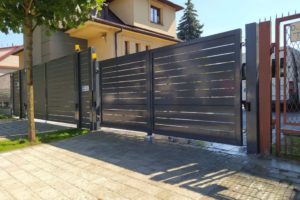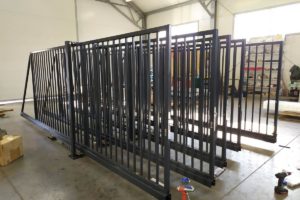
Entrance gate with operator
Solid entry gate with operator gives us a sense of security. Properly operated and cared for, it will serve us for many years.
At many houses, especially in villages or smaller towns, you can still see the entry gates opened manually. However, more convenient motorised gates are increasingly being used in modern construction. They can be opened and closed without getting out of the car.
The gate leaves are usually steel - welded from forged components or from rolled profiles (angles, flat bars, closed profiles of square or rectangular cross-section). The supporting frames are filled with rails, e.g. made of wood or special plastic slats, and often the infill is also steel.
Traditionalists often opt for wooden gates - made of solid wood or glulam - they emphasise the style of the house and its surroundings. They are set between posts of wood, concrete or steel.
Types of entrance gates:
- Swinging (casement) - hinged to the fence posts. Heavier wings require special, stronger posts. The wings should open inwards to the property.
- sliding on rail - the leaf of such a door moves on rollers on a rail placed in the ground.
- self-supporting sliding - you need more space along the fence for these because their wing is extended by a so-called counterweight. The suspended wing does not touch the ground.
A sliding gate on a rail is a cheaper and less complicated solution than a self-supporting sliding gate. However, dirt must be removed from the rail so as not to interfere with the operation of the gate.
Gate assembly
For the proper functioning of the door, proper installation is of great importance:
- a suitable foundation under the door should extend below the ground frost depth (depending on the climate zone). If this is not the case, so-called foundation blasting can occur in winter, which disrupts the established gate geometry, making it impossible to close and open;
- door levelling - crooked double-leaf doors may not close and misaligned sliding doors, especially self-supporting doors, may cause rapid wear of the guide bearings (moving an unbalanced door requires a great deal of force);
- the way the hinges are fitted - the wrong ones can cause the door to drop over time making it difficult to close. Inappropriate materials (e.g. poor quality hinges hinder the movement of the door and quickly rust) and poor design can also cause the door to warp and wedge.
Driven gates
The mechanism can be placed in the gate post, or it can be operated by remote control or magnetic card. Remote-controlled automatic entrance gates are most appreciated in cold weather, heavy snowfall and strong winds. It is then possible to drive into the yard without having to get out of the car. Proper installation and use are important for the proper functioning of a remote-controlled gate.
Any type of gate can be fitted with an operator - whether sliding or double-leaf. The operator should be selected according to the type of gate, its weight and frequency of opening and closing. It is also important that the door is installed correctly - a poorly fitted door is difficult to operate manually, so the operator will not work as well. Before installing an automatic gate opener, it is important to check that the gate structure is strong enough, then choose the right type of actuator and supply electricity to power it. The actuator mounted at the hinges is small in size, but it has to work with great force to set the heavy leaf in motion. It also has to overcome a high wind pressure force during operation, especially if the door has a large infill area - for example, tight boarding or sheeting.
For swing gates, the actuators should be mounted horizontally to the hinges and the leaves should have suitable reinforcement at these points. The operator should have a power reserve (although operators with more powerful actuators tend to be more expensive), as always running at maximum power will wear out more quickly.






